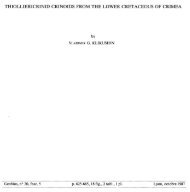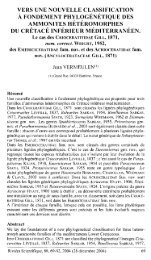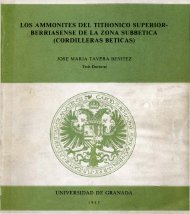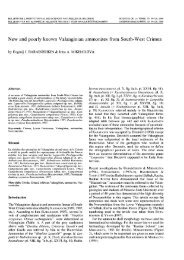peter franklin rawson, dennis curry, frank charles dilley, john michael ...
peter franklin rawson, dennis curry, frank charles dilley, john michael ...
peter franklin rawson, dennis curry, frank charles dilley, john michael ...
You also want an ePaper? Increase the reach of your titles
YUMPU automatically turns print PDFs into web optimized ePapers that Google loves.
and the coast of northern Brittany. South and east of Start Point the UpperCretaceous begins with glauconitic calcareous sandstones. These have yielded Orbitolinaof Cenomanian age. Overlying beds range at least up to the Campanian,although Turonian has not yet been proved. Further to the south, in the region ofthe Hurd Deep, neither Cenomanian nor Turonian rocks have been proved. Theoldest samples recorded are glauconitic chalks, which are Coniacian west of Guernseyand north of Lannion, and Santonian or Campanian south-west of Alderney,with a chalk succession up to Maastrichtian. South of Plymouth, Curry, Hersey et al.(1965) recorded Cenomanian and Coniacian (but not Turonian) samples in asequence with a minimum thickness of 25 m. Thicknesses of overlying stages wereestimated as: Santonian 50 m, Campanian 110 m, Lower Maastrichtian 110 m,Upper Maastrichtian 60 m. The last is overlain (apparently conformably) by 110 mof Danian. Westwards the Danian and higher Upper Cretaceous beds have beenremoved progressively by the sub-Eocene unconformity and south-west of theScillies the Eocene apparently rests on Santonian. Between the Scillies and HaigFras, grey Cenomanian and white Turonian and Coniacian chalks are well developed(Smith et al. 1965).D evon (Column 15)The Devon Cenomanian occurs as several dissimilar lithologies in a series ofscattered outliers, and includes the most marginal Upper Cretaceous facies representedin England. Hamblin & Wood (1976, with review of earlier literature)demonstrated on ammonite evidence that the topmost member (Cullum Sands withCherts) of their Haldon Sands Formation (see p. 42) is early Cenomanian, this datingpresumably applying also to highly fossiliferous devitrified cherts occurring ascobbles in the post-Cretaceous Aller Gravels around Kingskerswell. These haveyielded a well-preserved molluscan fauna incorrectly attributed to ‘Haldon’ inmuseum collections (see also Selwood et al., in press). We believe that the assignmentof an early Cenomanian age to the orbitoline limestones of Wolborough byHart (1971) is erroneous (see Hamblin & Wood 1976).The controversial dating of the whole of the Chert Beds and Top Sandstones ofthe east Devon coastal sections as Cenomanian on the basis of orbitoline and otherforaminiferal evidence (Hart 1973b; Carter & Hart, in press) has been refuted bythe discovery of an indigenous late Albian (dispar Zone) ammonite fauna close tothe junction of the Chert Beds and Top Sandstones near Shapwick Grange Farmnear Lyme Regis (Hamblin & Wood 1976: see also p. 42). However, the possibilitystill exists that the upper part of the Top Sandstones further west may be Cenomanian.In the Beer district, there are early Cenomanian chalky fissure deposits withinthe Top Sandstones below Bed A (Ali 1975).The ages of the Wilmington Sands and Cenomanian Limestones are fullydocumented by Kennedy (1970, with references). No thicknesses are given forsubdivisions Ai and A2, because wherever they each exceed about 2 m the divisionbetween them becomes vague. Smith (1961, p. 96) hazarded a maximum thickness
















